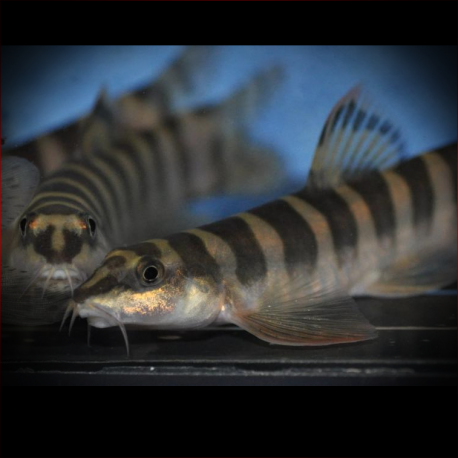More info
Datasheet
| Minimum Tank Size | 72 litres / 19.02 US gallons |
| Maximum Size | 7.3cm / 2.87inches |
| Temperature | 18°C / 64.40°F - 24°C / 75.20°F |
| Hardness | 2.02dgH / 36ppm - 12.05dgH / 215ppm |
| pH | 6.0-7.5 |
General Description
Schistura Hypsiura, commonly known as the Super Convict Loach, is a member of the Nemacheilidae family. It can be distinguished by its deep caudal peduncle, absence of dorsal or ventral skin crests along the caudal peduncle, and a deeply forked caudal fin. The species typically displays 6-8 regular bars along its flank and is part of the most species-rich genus among nemacheilid loaches, with a polyphyletic lineage containing over 190 members.
Aquarium Setup
The Schistura Hypsiura is not difficult to maintain in an aquarium that simulates a flowing stream or river habitat. It is recommended to set up the tank with variably-sized rocks, sand, fine gravel, and water-worn boulders. Addition of driftwood branches to create hiding spots and shade is beneficial. While most aquatic plants may not thrive, hardy varieties like Microsorum, Bolbitis, or Anubias can be attached to the décor. The species thrives in well-oxygenated water with some water movement, and regular water changes of 30-50% tank volume are advised.
Behaviour
Schistura Hypsiura is not highly aggressive and can coexist in a community aquarium if tankmates are carefully selected. It tends to do well in the presence of conspecifics and minimal aggression is expected if ample hiding spots are provided. The species does not school but benefits from the company of one or two schools of similar biotope inhabitants.
Feeding and Diet
In nature, Schistura Hypsiura is an omnivorous species, primarily consuming small insects, worms, crustaceans, and zooplankton. In an aquarium environment, they accept dried food but should also be offered live or frozen fare like Daphnia, Artemia, and bloodworms for optimal coloration and health.
Reproduction & Dimorphism
Reproduction behavior of Schistura Hypsiura is currently unrecorded. Males possess a triangular suborbital flap, while sexually mature females have a suborbital groove, with females appearing heavier-bodied than males.
Habitat and Distribution
The species is known only from the type locality in southern Rakhine State, western Myanmar. It inhabits short coastal rivers and streams, often in areas with high dissolved oxygen levels.
Please find additional details in the table provided above.

